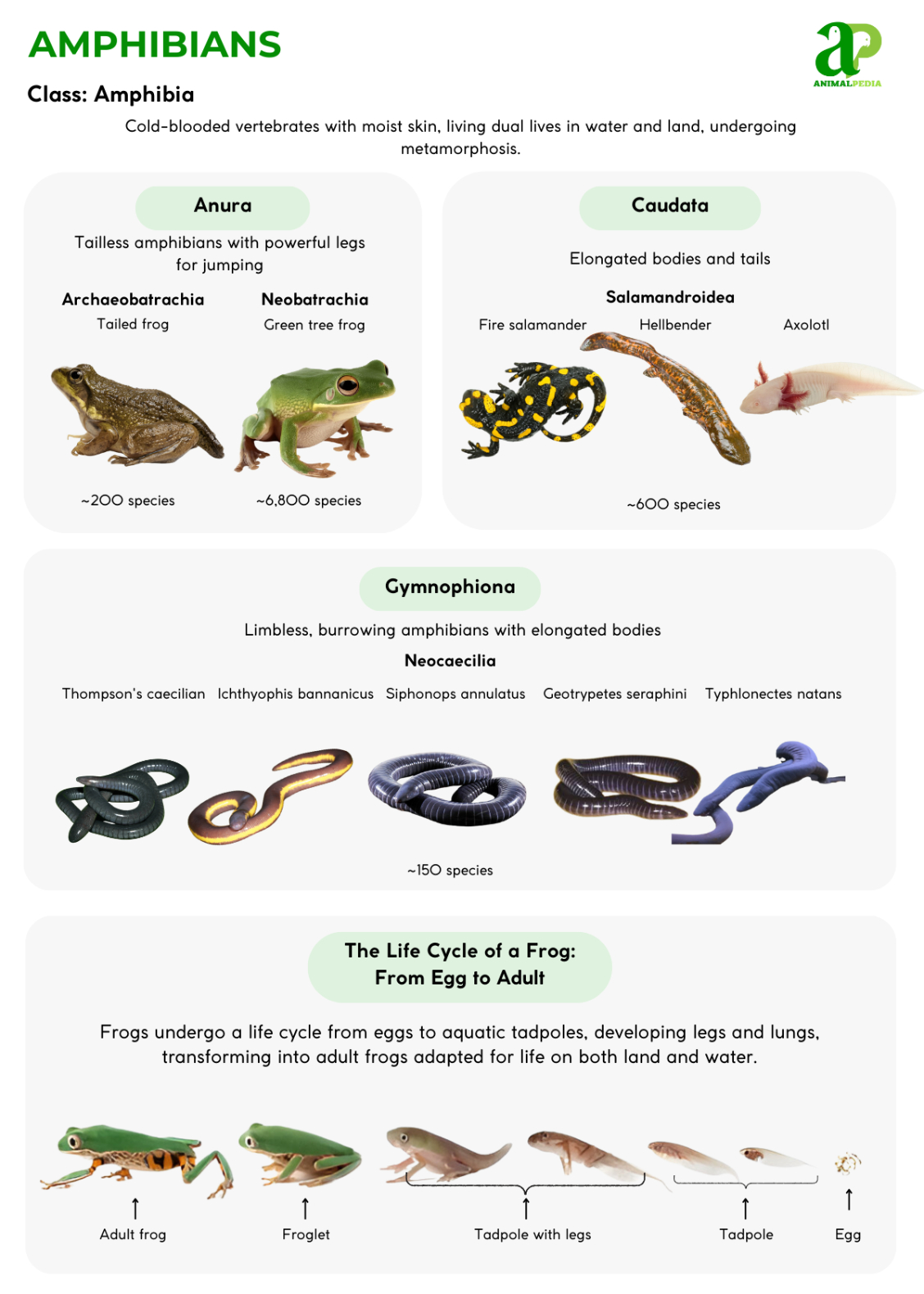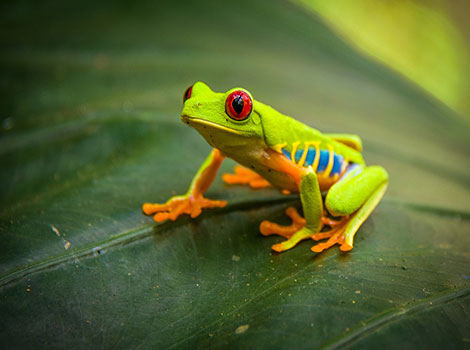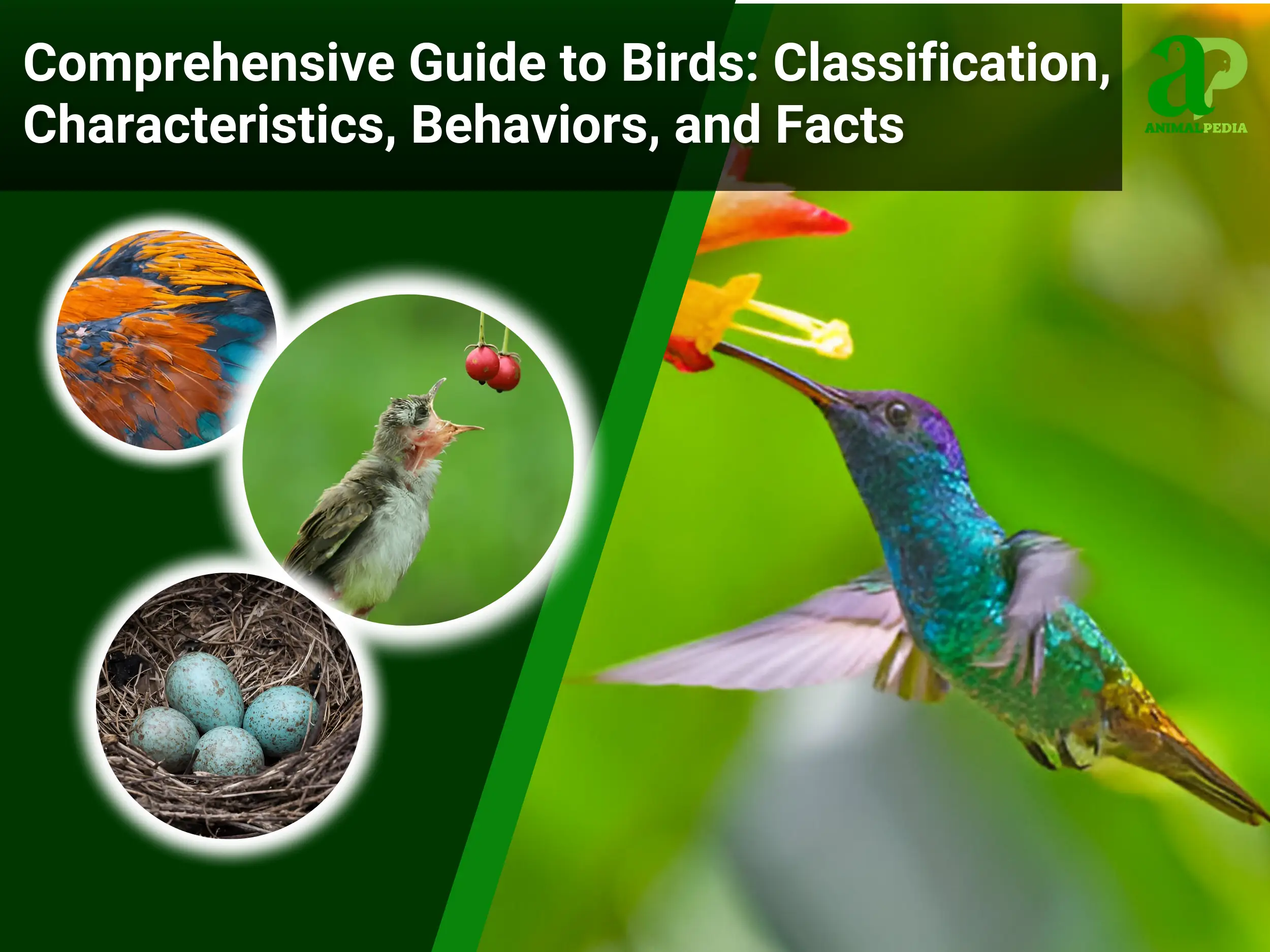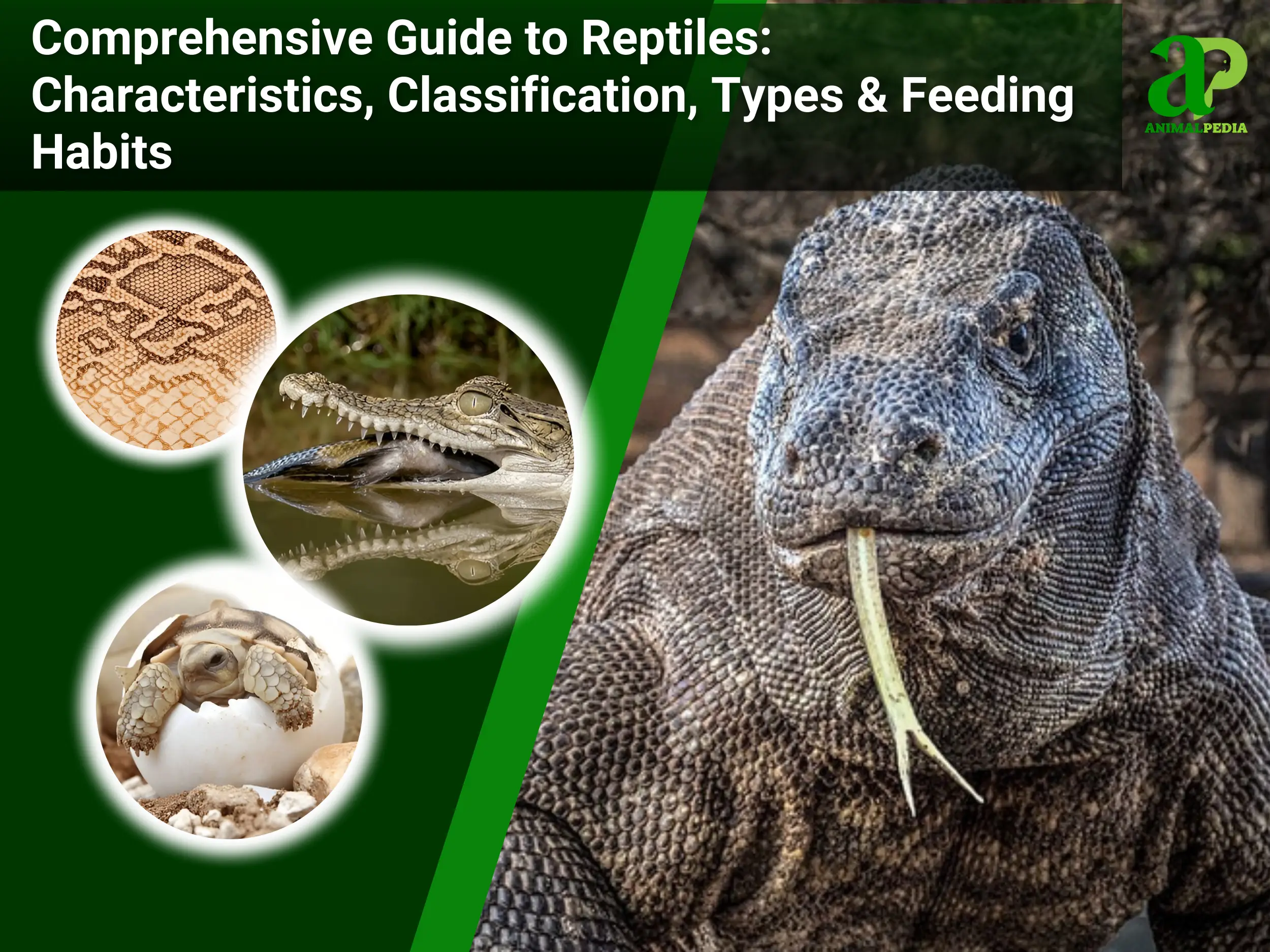Amphibians are tetrapod vertebrates belonging to the class Amphibia, characterized by their unique dual-life adaptation to both aquatic and terrestrial environments. With approximately 8,400 known species, amphibians inhabit diverse ecosystems across all continents except Antarctica.
The species of Amphibians range in size from just 0.3 in (7.7 mm) to 5.9 ft (1.8 meters). Amphibians are characterized by several distinctive features, including moist, permeable skin that aids in respiration, a three-chambered heart, and typically a biphasic life cycle involving aquatic larvae and terrestrial adults.
The Amphibians class is divided into three major orders: Anura (frogs and toads), Caudata (salamanders and newts), and Gymnophiona (caecilians). While most species undergo metamorphosis, some have evolved direct development or other specialized reproductive strategies.
The evolutionary history of amphibians dates back to the Devonian period, approximately 370 million years ago, when they became the first vertebrates to make the transition to land. As descendants of lobe-finned fish, early amphibians developed crucial adaptations including legs, lungs, and hearing structures that were later inherited by all terrestrial vertebrates. This evolutionary heritage makes them important subjects for understanding vertebrate evolution.
Amphibians display extraordinary behavioral and physiological adaptations. Their permeable skin requires sophisticated behavioral strategies for maintaining moisture balance and temperature regulation. Their life cycle and breeding strategies vary widely, from elaborate courtship displays to complex parental care behaviors. Many species have developed unique defense mechanisms, including toxic skin secretions and warning coloration.
Today, amphibians serve as crucial indicators of environmental health due to their sensitivity to environmental changes. They play vital roles in ecosystems as both predators and prey, helping to control insect populations and serving as food sources for various predators. However, they face numerous challenges, including habitat loss, disease, and climate change, making them one of the most threatened vertebrate groups.
This article delves into their unique anatomical features, survival strategies, and the conservation challenges they face. By exploring their fascinating adaptations and ecological importance, we gain a deeper appreciation for these fascinating creatures and their vital contributions to the natural world.
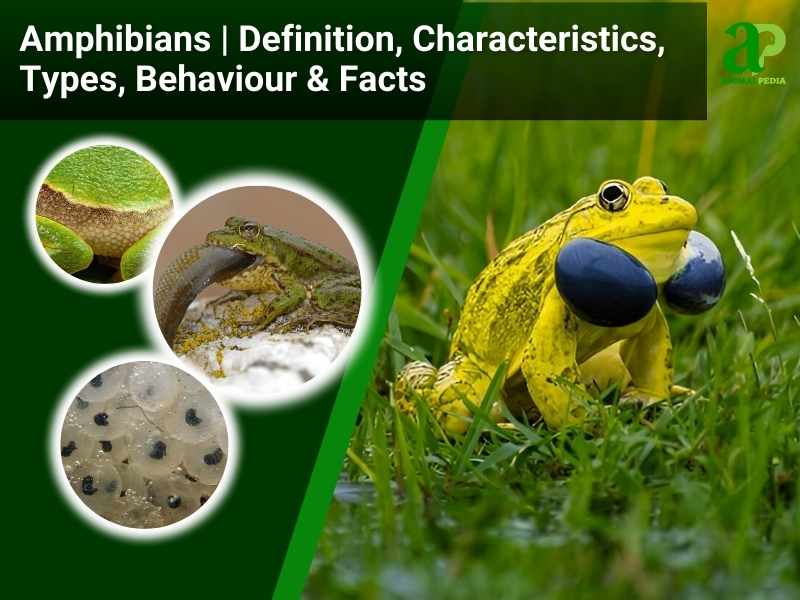
Contents
ToggleWhat are Amphibian characteristics?
Amphibians possess 8 unique features that allow them to thrive in both aquatic and terrestrial environments. The following key characteristics highlight their distinct biological and ecological traits:
- Moist Skin with Mucous and Poison Glands:
Amphibians possess specialized mucous glands that keep their skin moist, essential for respiration and preventing dehydration. Some species also develop poison glands that secrete toxins for defense, such as the highly toxic poison dart frogs (Dendrobatidae).
Moist skin facilitates cutaneous respiration, a primary method of gas exchange, particularly in lungless salamanders (Plethodontidae). The mucus also provides antibacterial properties, reducing infections and repelling parasites. Additionally, some amphibians change skin color in response to environmental changes, serving as bio-indicators of ecological shifts.
- Diverse Body Shapes:
Amphibians exhibit diverse body forms across three major orders:
-
-
- Anura (frogs and toads): Compact bodies with strong hind legs for jumping.
- Caudata (salamanders and newts): Elongated bodies with tails and short legs for crawling and swimming.
- Gymnophiona (caecilians): Legless, worm-like bodies suited for burrowing.
-
These adaptations aid survival—frogs escape predators with powerful jumps, salamanders maneuver efficiently on land and in water, and caecilians tunnel underground for protection and hunting.
- Limbs and Webbed Feet:
Most amphibians have four limbs with five digits, except legless caecilians. Webbed feet are common among aquatic species, optimizing movement in water.
Frogs’ long, muscular hind legs allow for impressive leaps, while salamanders’ limbs support crawling and swimming. Tree frogs (Hylidae) use adhesive toe pads for climbing, and webbed feet in aquatic amphibians enhance swimming efficiency by increasing surface area for propulsion.
- Large, Bulging Eyes and Nictitating Membrane:
Amphibians have large, protruding eyes that provide a wide field of vision, crucial for detecting predators and prey. They also possess a nictitating membrane, a translucent third eyelid that protects the eyes while maintaining visibility.
This membrane prevents dehydration and shields the eyes underwater. Interestingly, some amphibians use their eyes to aid swallowing by pushing food down their throats.
- Tympanic Membrane (External Eardrum):
Located behind the eyes, the tympanic membrane is a key auditory structure that detects sound vibrations, essential for communication and predator awareness.
In some frog species, such as Rana spp., males develop larger tympanic membranes to better detect mating calls, enhancing reproductive success.
- Multiple Respiration Methods (Lungs, Skin, and Gills):
Amphibians utilize multiple respiration methods throughout their lifecycle. Larvae, such as tadpoles, rely on external gills for underwater respiration. As they mature, many develop lungs while retaining skin respiration.
Some salamanders, particularly those in the Plethodontidae family, lack lungs entirely and depend solely on skin respiration. This flexibility allows amphibians to thrive in varying environments, utilizing gills or skin respiration in water and lung breathing on land.
- Tail (Present in Salamanders and Caecilians, Lost in Frogs):
While salamanders and caecilians retain tails for life, frogs and toads undergo metamorphosis, during which their tails are resorbed.
A tail enhances locomotion in water, aids balance, and serves as an energy reserve. Many salamanders possess regenerative abilities, enabling them to regrow lost tails, a valuable survival mechanism against predators.
- Body Size and Coloration:
Amphibians vary significantly in size, from the Paedophryne amauensis frog (7.7 mm) to the Chinese giant salamander (Andrias davidianus, over 1.8 meters). Their coloration often serves critical functions:
-
-
- Camouflage: Many species, like Plethodon salamanders, alter their skin color to blend into their surroundings.
- Predator deterrence: Brightly colored species, such as poison dart frogs, signal toxicity, warning potential predators.
- Mate attraction: During breeding seasons, males of some species develop vibrant hues to attract females.
-
Each of these adaptations contributes to amphibians’ survival, making them one of the most versatile vertebrate groups on Earth.
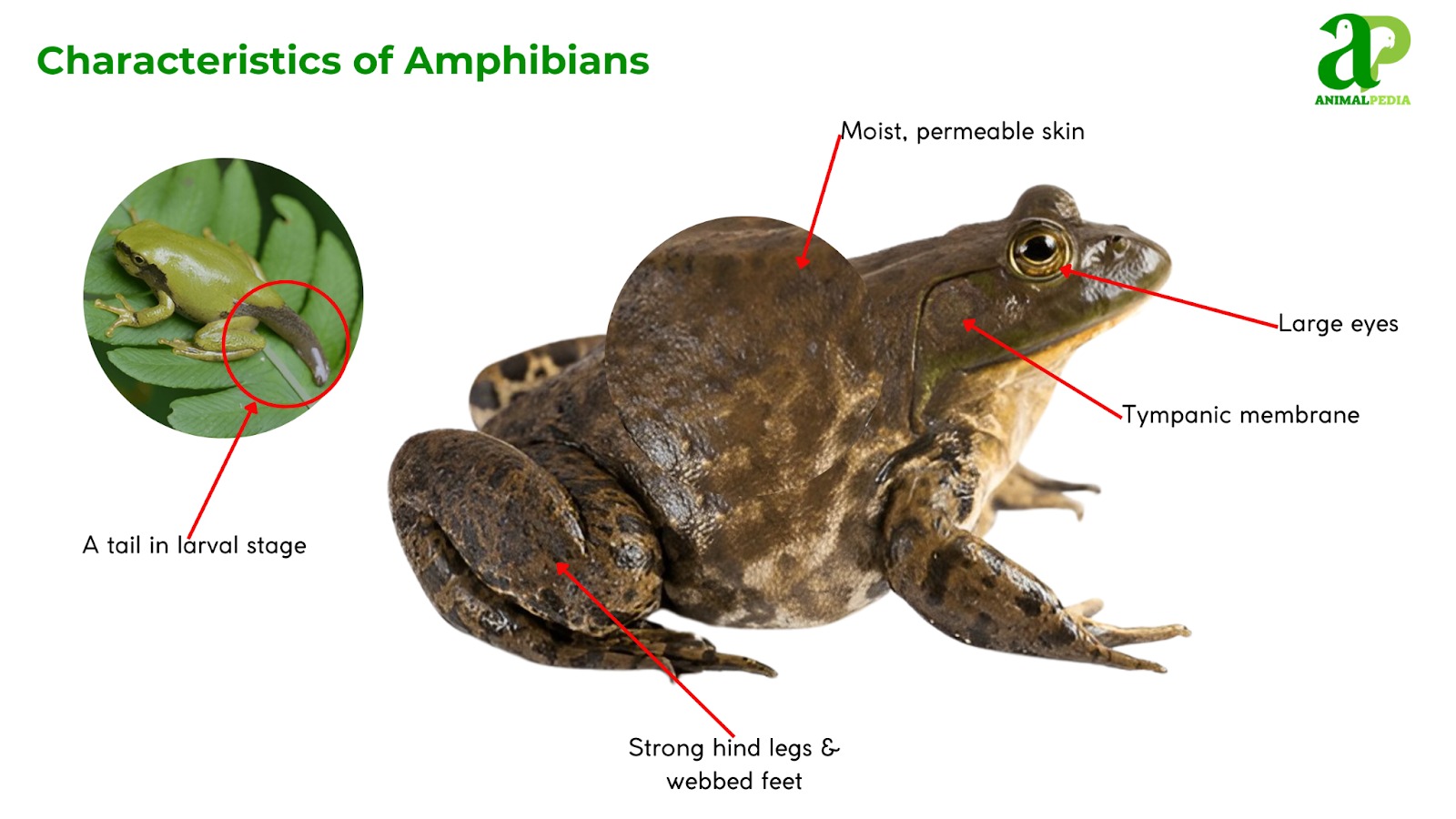
Which is the exception of amphibians?
There are 5 exceptions of the Amphibians, including Pacman Frog, Glass Frogs, Axolotl, African Bullfrog, and Red-Eyed Tree Frog based on distinct morphological, physiological, and behavioral adaptations.
- Morphological adaptations
Some species show significant divergence from typical amphibian body structures. The Pacman Frog exemplifies this with its distinctive round body and disproportionately large mouth – adaptations that optimize ambush predation rather than the agile movement seen in most amphibians.
Similarly, Glass Frogs have evolved transparent ventral skin that provides unique camouflage capabilities, departing from the typical cryptic coloration strategies used by most amphibians.
- Developmental patterns
The most striking example is the Axolotl, which exhibits neoteny – retaining juvenile characteristics into adulthood. Unlike most amphibians that undergo metamorphosis to become terrestrial adults, Axolotls maintain larval features like external gills and remain fully aquatic throughout their lives.
- Physiological adaptations
The African Bullfrog demonstrates impressive adaptation to arid environments through increased body mass for water retention and burrowing capabilities. This contrasts sharply with most amphibians’ requirement for consistently moist environments.
- Defensive mechanisms
Some species have evolved unique strategies. The Red-Eyed Tree Frog employs startle coloration rather than traditional amphibian defenses like camouflage or toxins. When threatened, it reveals its bright colors and red eyes to startle predators – a dramatic departure from typical amphibian defensive strategies.
These exceptions highlight the incredible adaptability of amphibians and their capacity to evolve specialized traits that diverge from standard characteristics while still maintaining their fundamental amphibian nature.
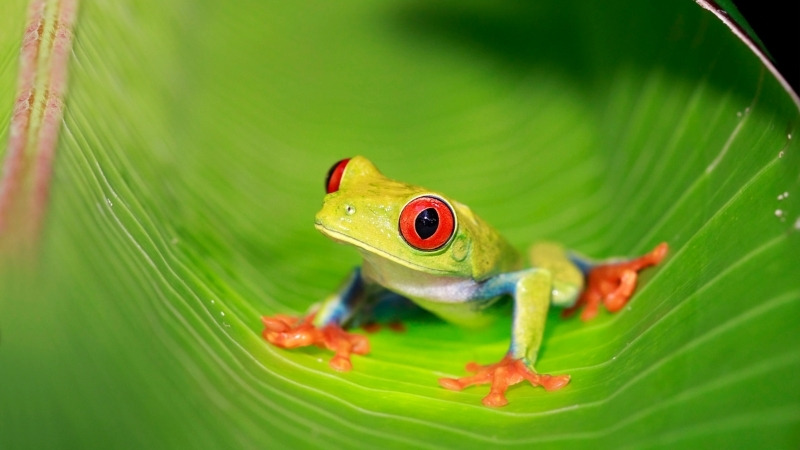
How are Amphibians classified?
Amphibians are classified based on three main approaches. The classical Linnaean classification relies on morphology to identify shared characteristics among species. Phylogenetic classification examines evolutionary relationships to reconstruct a more accurate phylogenetic tree. Meanwhile, modern methods based on DNA analysis and Comparative Genomics utilize advanced technology to study genetic relationships, offering deeper insights into the evolution and biodiversity of this animal group.
In Amphibians, there are three orders with distinctive features as follows.
- Order Anura (Examples: Frogs and toads): Anurans undergo a complete metamorphosis, transitioning from aquatic larvae (tadpoles) to terrestrial adults. Their skin is often permeable, allowing for gas exchange and moisture absorption.
- Order Urodela (Examples: Salamanders, newts) Urodeles generally have a more direct life cycle and may exhibit aquatic and terrestrial stages, with many species capable of regenerating lost limbs.
- Order Gymnophiona (Examples: Caecilians) These amphibians are characterized by their elongated, cylindrical bodies and are typically found in tropical environments. They have reduced or absent eyesight and rely on their other senses to navigate their surroundings.
The classification of amphibians reflects their diverse adaptations and ecological roles. Ongoing research in genetics, ecology, and evolutionary biology continues to enhance our understanding of amphibian relationships, leading to a more comprehensive classification system that captures the complexity of this fascinating group of animals.
Here’s the diagram of the Amphibians’ Classification:
Class: Amphibia
└── Subclass: Lissamphibia
├── Order: Anura
│ ├── Suborder: Archaeobatrachia
│ └── Suborder: Neobatrachia
├── Order: Caudata
│ └── Suborder: Salamandroidea
└── Order: Gymnophiona
└── Suborder: Neocaecilia
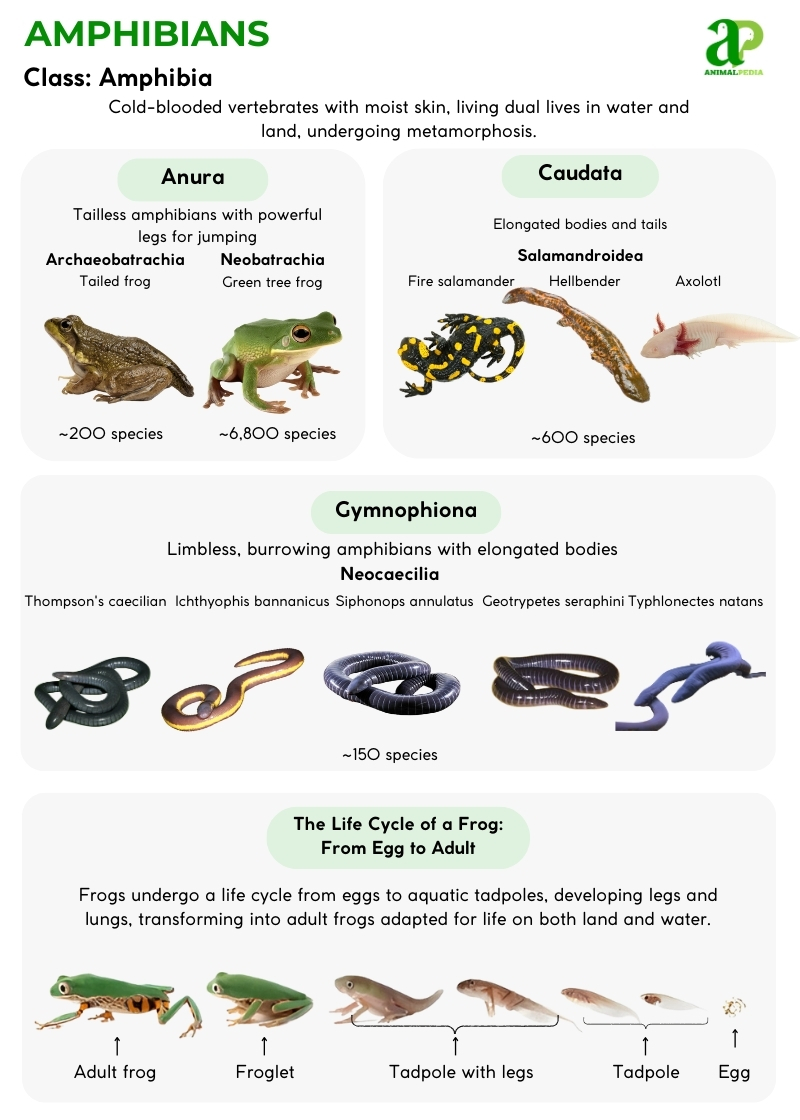
What did Amphibians evolve from?
Amphibians are believed to have evolution of fish, specifically from a group of ancient fishes known as lobe-finned fishes (Sarcopterygii). These fishes had fleshy, lobed fins that could be used for movement in shallow water or on land, setting the stage for the emergence of terrestrial vertebrates.
Their journey from fully aquatic ancestors to the diverse group we see today highlights one of the most significant evolutionary transformations in Amphibians’ history.
- Lobe-Finned Fish (Sarcopterygii) – ~400 Million Years Ago (MYA)
One of the earliest precursors to amphibians, lobe-finned fish such as Eusthenopteron (385 MYA) exhibited key adaptations that laid the foundation for the evolution of tetrapods. These fish had lobe-finned appendages with bone structures resembling limbs, allowing for limited movement on solid surfaces.
They also possessed both lungs and gills, enabling them to extract oxygen from air and water. Living in shallow freshwater environments, their strong fins provided stability, helping them push against the substrate.
- Transitional Fish-Tetrapod (Tetrapodomorphs) – ~375 MYA
As fish evolved to spend more time in shallow waters, some species, like Tiktaalik (375 MYA), developed features that allowed them to explore land. This species had wrist bones, which gave it the ability to prop itself up in shallow water and possibly on land.
Additionally, it developed rudimentary lungs to survive in oxygen-poor waters, while its neck mobility allowed independent head movement, a feature absent in fish. With a flattened skull and strong ribs, Tiktaalik had the necessary adaptations to support itself outside water for extended periods.
- Early Amphibian-like Tetrapods – ~365 MYA
The next evolutionary step saw the emergence of early tetrapods like Acanthostega and Ichthyostega, which displayed significant advancements toward terrestrial life. These species were among the first to develop digits (fingers & toes)—with Acanthostega having eight digits per limb.
Their lungs became more specialized for air-breathing, but the presence of gills indicated that they still relied on aquatic environments. Their weak limbs and webbed feet suggested they were better suited for swimming rather than walking on land.
- True Amphibians (Temnospondyls & Lepospondyls) – ~340-250 MYA
By the Carboniferous and Permian periods, early amphibians such as Eryops and Mastodonsaurus had evolved stronger adaptations for terrestrial life. They developed stronger limbs and robust vertebrae, allowing them to move more efficiently on land.
Unlike their predecessors, adult forms lost their gills, relying entirely on lungs for respiration. Their large skulls and strong jaws enabled a carnivorous diet, and they developed thicker skin, though still requiring moisture for survival.
- Origin of Modern Amphibians (Lissamphibia) – ~250 MYA
The evolution of modern amphibians began around 250 MYA with species like Gerobatrachus, an ancestor of today’s frogs and salamanders. These early amphibians had smaller body sizes, reducing water loss and increasing mobility.
A crucial adaptation was the development of highly permeable skin, which allowed for cutaneous respiration (breathing through the skin). The appearance of metamorphosis, transitioning from a tadpole to an adult form, became a defining trait. Additionally, their lighter skulls and reduced armor made them more agile.
- Evolution of Modern Amphibians (Mesozoic: 250–66 MYA)
During the Mesozoic era, early Lissamphibia, the ancestors of modern amphibians, began to emerge. This period, spanning from the Triassic to the Cretaceous (250–66 MYA), saw the evolution of key amphibian traits, including permeable skin, external fertilization, and metamorphosis.
These adaptations allowed amphibians to thrive in moist environments and survive major environmental changes. Unlike many prehistoric species, they endured mass extinctions by relying on water-rich habitats, eventually giving rise to today’s frogs, salamanders, and caecilians.
- Survival Through Mass Extinctions (66 MYA – Present)
Following the Cretaceous-Paleogene extinction event (66 MYA), modern amphibians—including frogs (Anura), salamanders (Urodela), and caecilians (Gymnophiona)—continued to diversify and spread globally. While some ancient groups, such as giant amphibians, went extinct, others successfully adapted to new ecosystems.
Today, amphibians face increasing threats from climate change, habitat destruction, and chytrid fungus, which endanger many species. Despite these challenges, their resilience and adaptability have allowed them to persist for millions of years.
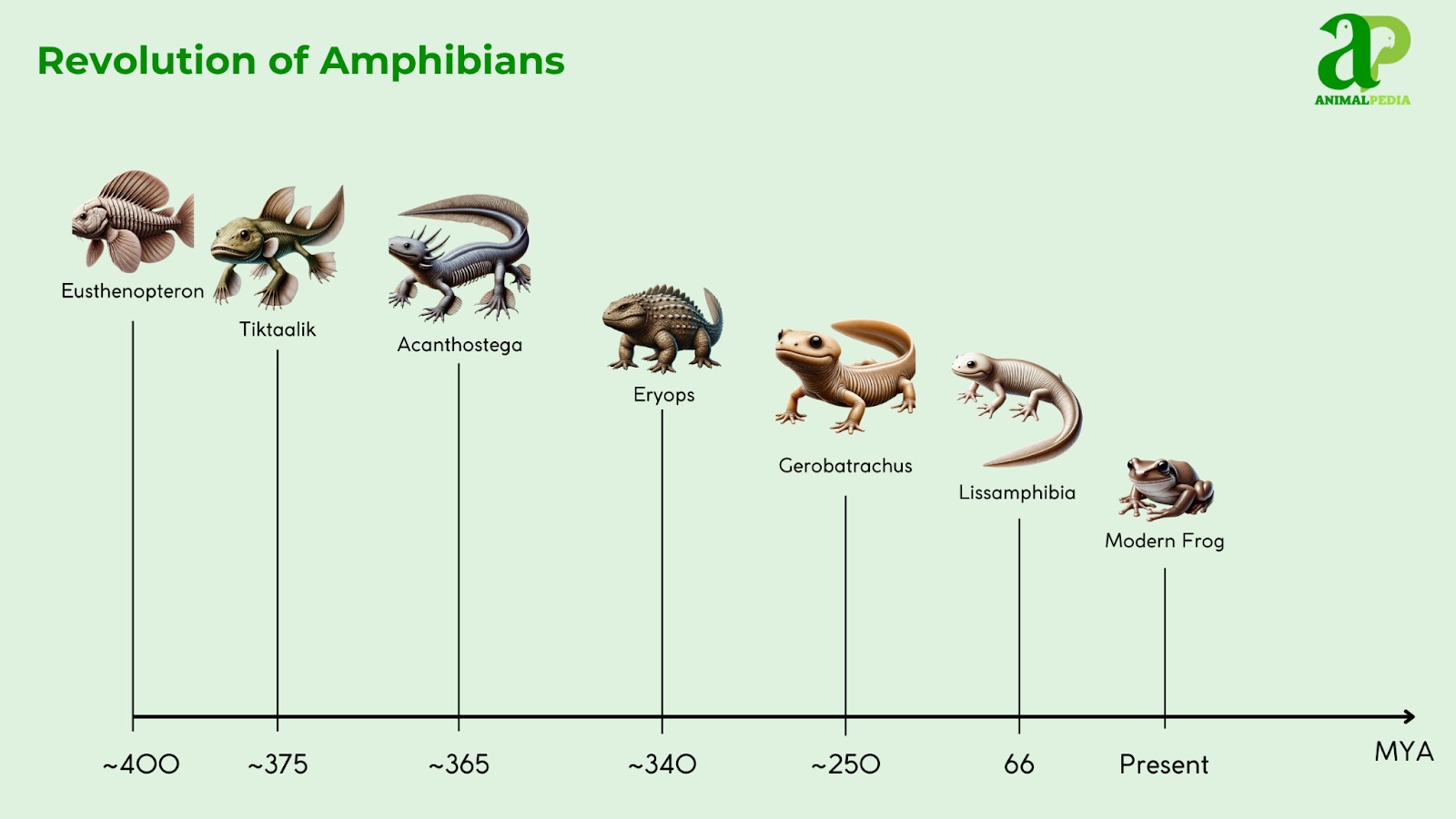
What adaptations do Amphibians have for living?
Amphibians have evolved sophisticated physiological systems, that enable them to successfully transition between aquatic and terrestrial environments. These adaptations include specialized nervous, digestive, excretory, and respiratory systems that work together to support their unique dual-environment lifestyle. Let’s explore each of these systems in detail to understand how they contribute to amphibian survival.
- Nervous System
The amphibian nervous system consists of a well-developed brain and spinal cord network that enables sophisticated environmental interaction. The brain contains three main regions: the forebrain (controlling smell and behavior), midbrain (visual processing), and hindbrain (movement coordination and basic functions). This neural organization supports critical survival behaviors such as predator detection and prey capture.
These animals possess specialized sensory adaptations, including lateral line systems in aquatic species for detecting water movement and highly developed inner ears for hearing both airborne and underwater sounds. An interesting exception is found in certain salamander species that have lost their eyes through evolution but compensate with enhanced chemical and tactile sensing abilities.
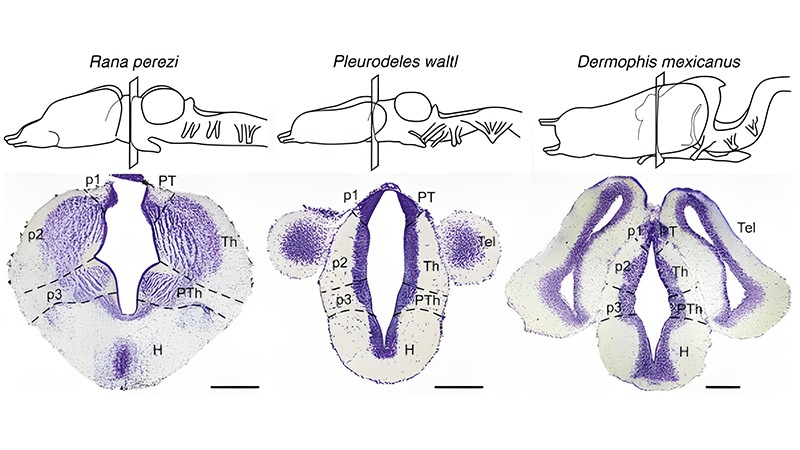
- Digestive System
Amphibians possess a complete digestive tract adapted for efficient nutrient extraction from diverse food sources. The system begins with a specialized tongue that can be rapidly projected to catch prey – a unique adaptation not found in other vertebrates. The digestive tract includes a stomach with strong acids for breaking down insects and other prey, and a relatively short intestine for nutrient absorption.
Most amphibians practice extracellular digestion, but some salamanders exhibit the unusual ability to absorb nutrients directly through their skin. Another notable exception is found in certain frog species that can survive extended periods without food by reducing their metabolic rate and digestive organ size.
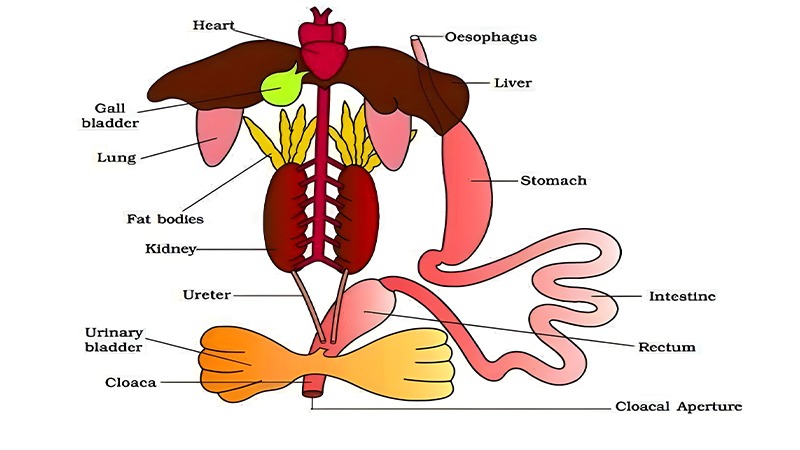
- Excretion
The amphibian excretory system efficiently manages waste removal while maintaining crucial water balance. Their kidneys are more advanced than those of fish but simpler than those of mammals. A unique feature is their ability to modify urine concentration based on their environment – producing dilute urine when in water and concentrating it when on land.
The system includes a urinary bladder that serves both waste storage and water conservation functions. Some species can reabsorb water through their bladder wall during dry periods – a critical adaptation for survival in terrestrial environments.
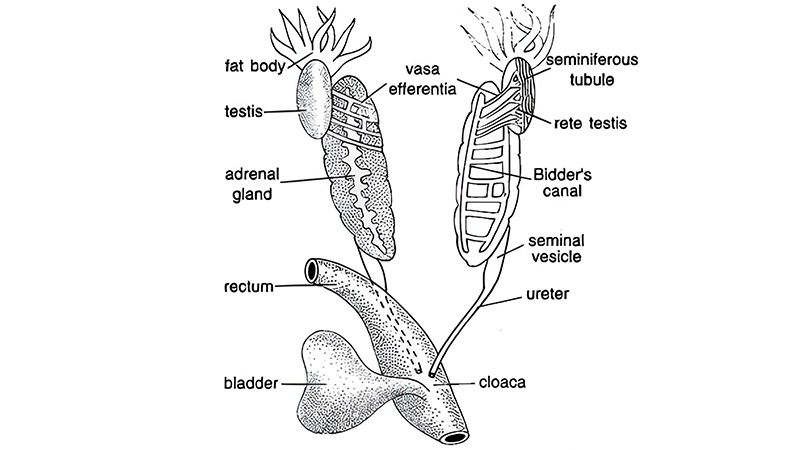
- Respiration
Amphibians employ a sophisticated multi-modal respiratory system that includes pulmonary (lung) and cutaneous (skin) breathing. Their highly vascularized skin allows for oxygen absorption, particularly important during aquatic phases or hibernation. While simpler than other mammals, the lungs provide effective gas exchange during terrestrial activity.
A unique adaptation is their ability to shift between different modes of respiration based on environmental conditions and activity levels. Some salamanders have even lost their lungs entirely, relying completely on cutaneous respiration – an exceptional case demonstrating amphibian respiratory strategies’ adaptability.
Three Orders of Amphibians
The taxonomy of amphibians highlights their ecological importance, categorized into three orders based on traits and evolutionary history: Anura, Caudata, and Gymnophiona. Anura (frogs and toads) dominates with 88%, shown in light green. Urodela (salamanders and newts) makes up 10%, in dark green. Gymnophiona (caecilians) is the smallest group at 2%, in a darker shade.
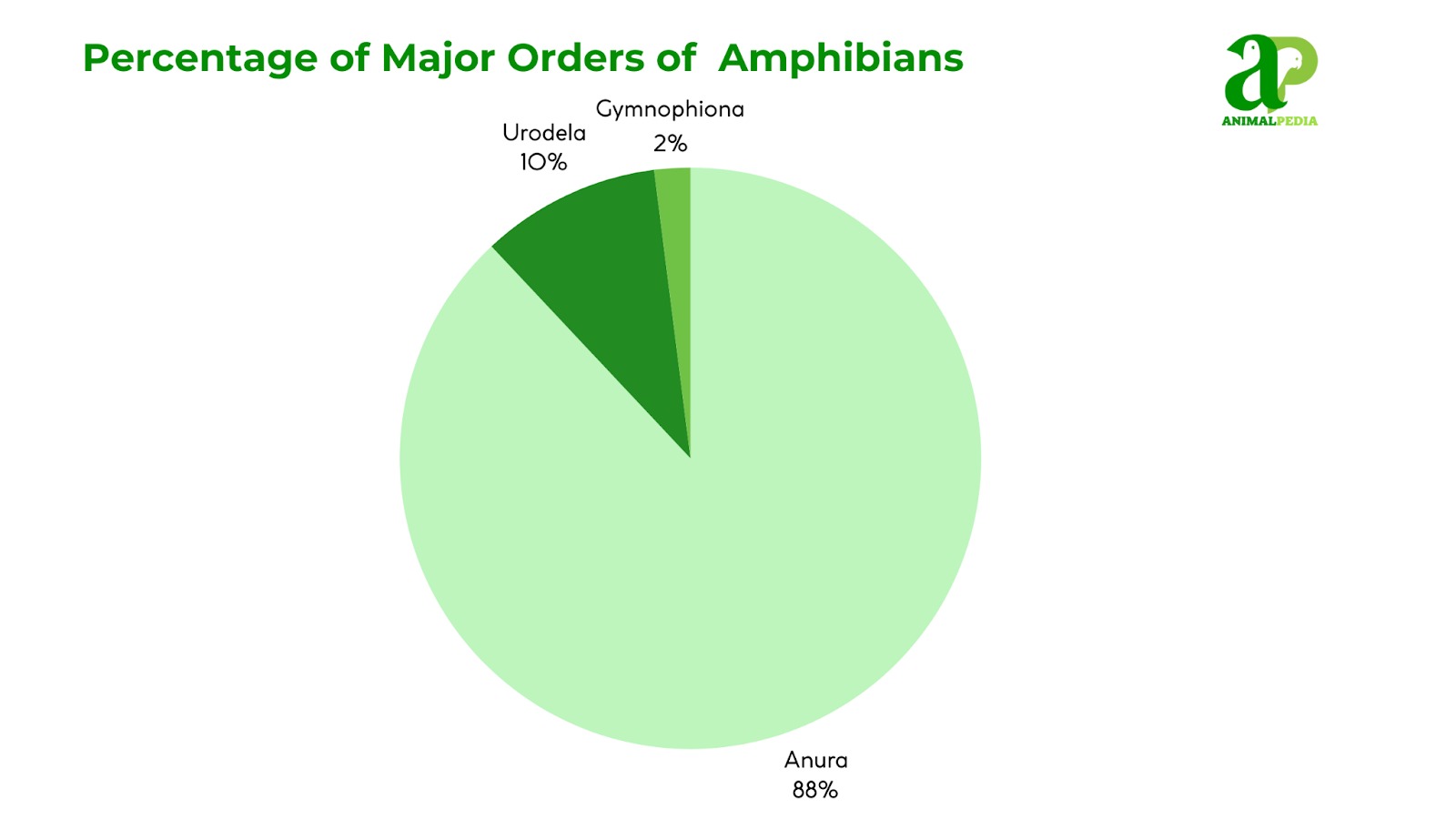
- Anura (Salientia):
Anura represents the largest and most diverse order of amphibians, distinguished primarily by their powerful, elongated hind legs adapted for jumping and their tailless adult form. This order includes familiar species like the American Bullfrog (Rana catesbeiana), European Common Toad (Bufo bufo), and Red-Eyed Tree Frog (Agalychnis callidryas). Like other amphibians, they share the common trait of moist, permeable skin for respiration.
Anurans inhabit various environments from tropical rainforests to arid deserts, though most species require water or moist environments for breeding. They undergo complete metamorphosis, starting life as aquatic tadpoles before developing into terrestrial adults. Their unique body structure includes a shortened vertebral column, elongated ankle bones, and specialized shoulder girdle for landing after jumps.
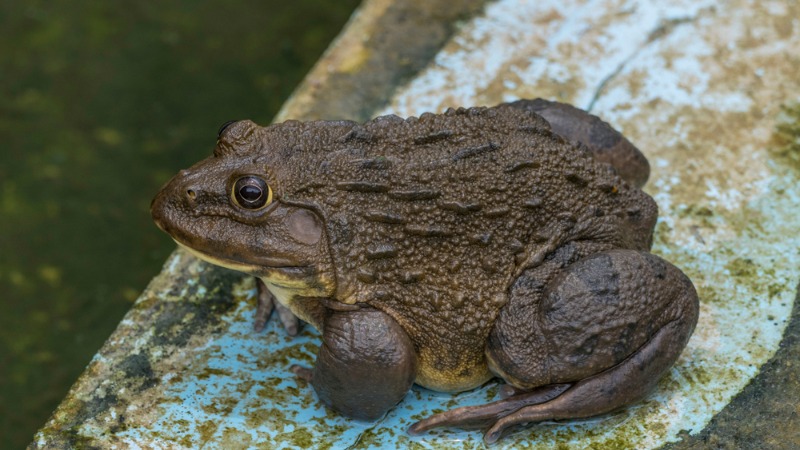
- Caudata (Urodela):
Caudata comprises salamanders and newts, instantly recognizable by their lizard-like appearance with elongated bodies and prominent tails that persist throughout their lives. Notable examples include the Fire Salamander (Salamandra salamandra), Chinese Giant Salamander (Andrias davidianus), and Eastern Newt (Notophthalmus viridescens).
These amphibians typically inhabit moist, temperate forests and mountain streams of the Northern Hemisphere. Most species lay eggs in water, though some exhibit direct development or live birth. A distinctive feature of this order is their extraordinary ability to regenerate lost limbs, tails, and even some internal organs.
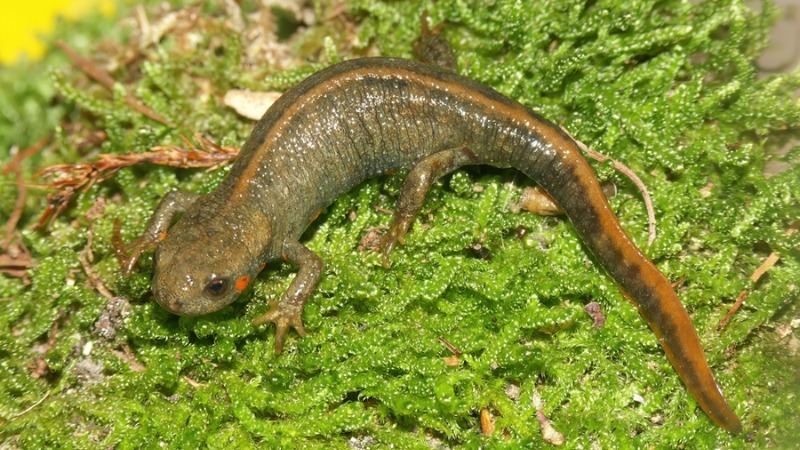
- Gymnophiona (Apoda):
Gymnophiona represents the most specialized order, consisting of limbless, worm-like caecilians adapted for a fossorial (burrowing) lifestyle. Common species include the Ringed Caecilian (Siphonops annulatus) and Yellow-Striped Caecilian (Ichthyophis kohtaoensis).
Unlike their amphibian relatives, caecilians spend most of their lives underground in tropical regions of South America, Africa, and Southeast Asia. They have evolved unique features for their burrowing lifestyle, including a robust skull for digging, reduced eyes covered by bone, and sensory tentacles near their snouts. Most species exhibit internal fertilization and can either lay eggs or give birth to live young.
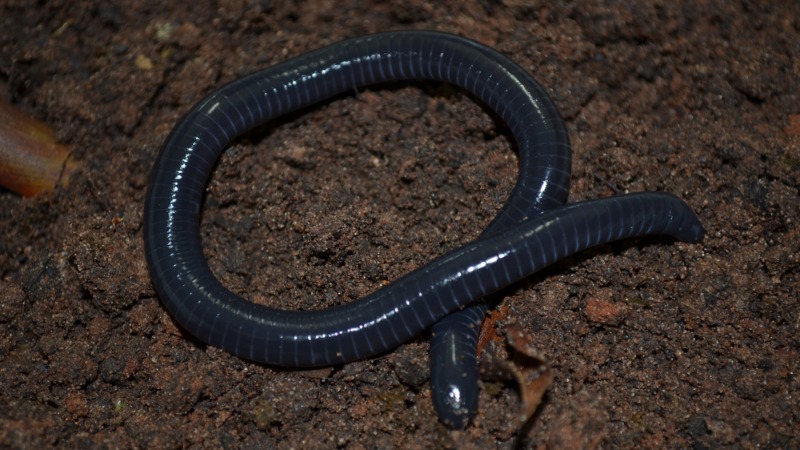
How many types of Amphibians are there?
There are over 8,400 known species of amphibians today. This table highlights 65 species, showcasing the extensive diversity and adaptations of amphibians across different habitats worldwide:
| Anura | Caudata | Gymnophiona |
| American Bullfrog | Eastern Tiger Salamander | Common Caecilian |
| Common Frog | Axolotl | Rubber Eel |
| Green Tree Frog | Red-spotted Newt | Purple-striped Caecilian |
| Wood Frog | Japanese Salamander | Indian Caecilian |
| Poison Dart Frog | Fire Salamander | Yellow-striped Caecilian |
| African Bullfrog | Alpine Salamander | Boulengerula |
| European Tree Frog | Mud Salamander | Malagasy Caecilian |
| Pacific Tree Frog | Long-toed Salamander | Black Caecilian |
| Common Toad | Blue-spotted Salamander | Giant Caecilian |
| Leopard Frog | Spotted Salamander | Burmese Caecilian |
| Tree Frog | Northern Two-lined Salamander | Caecilian (Amphibian) |
| Woodhouse’s Toad | Western Tiger Salamander | Colombian Caecilian |
| Goliath Frog | Clouded Salamander | Caecilian (Tropical) |
| Bullfrog | California Newt | South American Caecilian |
| Spring Peeper | Southern Two-lined Salamander | African Caecilian |
| White’s Tree Frog | Green Salamander | Tropical Caecilian |
| Mountain Yellow-legged Frog | Marbled Salamander | Philippine Caecilian |
| Surinam Toad | Carolina Northern Two-lined Salamander | West African Caecilian |
| Congo Frog | Nightcrawler | Indonesian Caecilian |
| Fire-bellied Toad | Chaco Salamander | Rainforest Caecilian |
| Red-eyed Tree Frog | Bayou Salamander | Nile Caecilian |
| Amazon Milk Frog | Chestnut Salamander | Sri Lankan Caecilian |
| Wood Frog | Chaco Salamander | Lesser Caecilian |
| Amazon Poison Frog | Bullfrog | Giant Rainforest Caecilian |
| Horned Frog | Rough-skinned Newt | Aquatic Caecilian |
| Brazilian Tree Frog | White-spotted Salamander | West African Giant Caecilian |
| Tomato Frog | Nightcrawler | Central American Caecilian |
| Golden Poison Dart Frog | Carolina Northern Two-lined Salamander | South Asian Caecilian |
| Northern Leopard Frog | Chaco Salamander | Caribbean Caecilian |
| South American Horned Frog | Marbled Salamander | Madagascan Caecilian |
What are the behaviors of insects?
The behaviors of amphibians are an intriguing showcase of their adaptability and survival strategies across both aquatic and terrestrial environments. These behaviors span feeding habits, locomotion, communication, reproduction, and defense mechanisms, reflecting their evolutionary success:
- Feeding Habits: Amphibians exhibit diverse diets ranging from herbivorous larvae to carnivorous adults, utilizing specialized hunting strategies to capture prey.
- Locomotion: Amphibians demonstrate varied locomotion styles, including walking, jumping, swimming, burrowing, and even gliding, supported by their unique anatomical adaptations.
- Communication: Amphibians communicate through vocalizations, visual displays, chemical cues, and tactile interactions, serving purposes such as mating, territory establishment, and predator deterrence.
- Reproduction: Amphibian reproduction includes diverse strategies, from egg-laying in aquatic environments to advanced parental care behaviors.
- Defense Mechanisms: Amphibians employ camouflage, mimicry, and poison secretion to evade predators and ensure survival in challenging environments.
Let’s begin by exploring the feeding habits of amphibians and their fascinating adaptations for survival.
Diet & Feeding
Amphibians have 2 diet and feeding habits that change throughout their life cycle. Their diet depends on species, habitat, and life stage (larvae vs. adult). Most amphibians are carnivorous as adults but have herbivorous or omnivorous larvae. This transition in feeding habits reflects their adaptation to different ecological niches.
- Larval Diet (Tadpoles & Larvae)
During their early life stage, amphibian larvae, especially tadpoles, develop specialized mouthparts for scraping, filtering, or consuming plant material. Some species also develop gills to survive in aquatic environments. Herbivorous tadpoles primarily feed on algae, aquatic plants, and detritus, ensuring a steady intake of nutrients.
Omnivorous species consume small invertebrates and decomposing organic matter, while carnivorous tadpoles, such as spadefoot toads, hunt tiny aquatic animals or even other tadpoles. Feeding mechanisms vary, with bullfrog tadpoles relying on filter feeding and others using keratinized mouthparts to scrape algae from rocks.
- Adult Diet (Carnivorous Predators)
As they transition into adulthood, most amphibians become carnivorous predators, equipped with wide, sticky tongues for capturing prey. Many species possess sharp, peg-like teeth (maxillary and vomerine teeth) that help grip their catch, while some aquatic species, such as newts, rely on suction feeding. Their diet includes various insects, arthropods, worms, mollusks, and small vertebrates.
Larger amphibians, like bullfrogs and salamanders, may eat fish, mice, and even other amphibians. Some species exhibit cannibalistic behavior when food is scarce. Feeding mechanisms vary, including tongue projection in frogs, suction feeding in aquatic species, and ambush hunting in motionless predators.
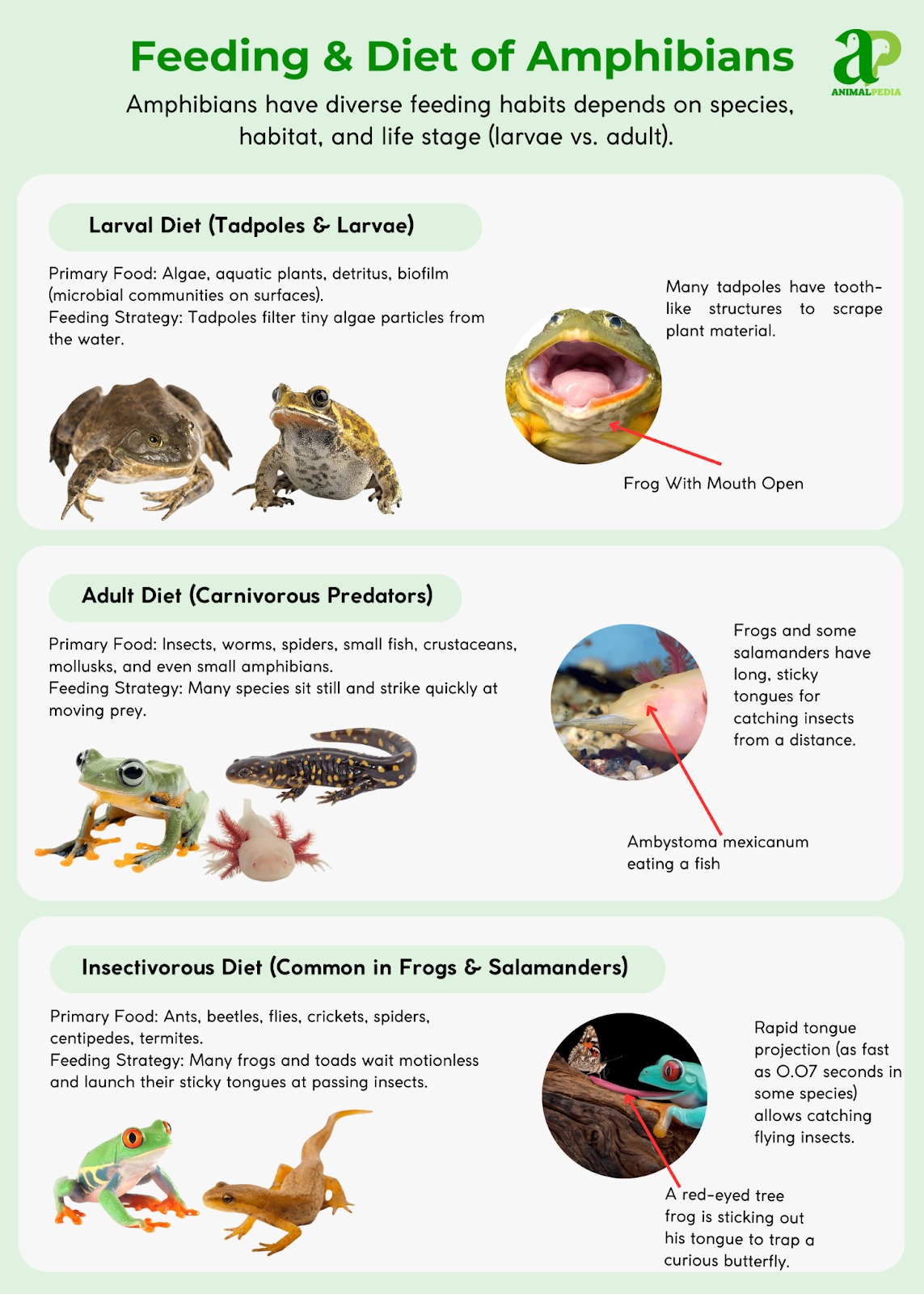
Different amphibians employ unique feeding strategies suited to their environments. Arboreal frogs use long tongues to snatch flying insects, while burrowing amphibians, such as caecilians, feed on underground invertebrates like earthworms. Aquatic species, including axolotls and giant salamanders, use suction feeding or hunt small fish and crustaceans. Certain toads, such as the Cane toad, secrete toxins to subdue prey, providing an advantage in capturing food.
Amphibians possess a simple digestive system with a short intestine, designed for processing protein-rich diets efficiently. Their metabolism is ectothermic (cold-blooded), meaning digestion depends on environmental temperature. This adaptability allows certain species, such as hibernating frogs, to endure long fasting periods during harsh conditions. By adjusting their diet and feeding mechanisms, amphibians demonstrate remarkable versatility in food acquisition, ensuring survival across diverse ecosystems.
Locomotion of Amphibians
Amphibians use 6 movement methods, adapted to their environments through specialized body structures.
- Walking or Crawling
Amphibians like salamanders have well-developed, muscular limbs and a flexible spine. These features support walking or crawling by providing the necessary force and flexibility for movement across terrestrial environments. For example, the Eastern Newt (Notophthalmus viridescens) often walks or crawls along the bottom of ponds or on wet forest floors in search of food.
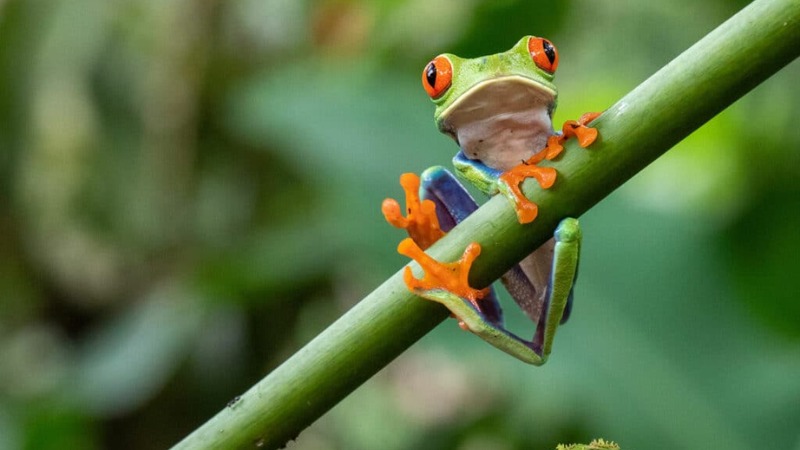
- Jumping
Frogs have elongated, powerful hind legs with strong muscles. This adaptation allows for explosive jumps, facilitating rapid escape from predators or quick movements to catch prey. For example, the Red-eyed Tree Frog (Agalychnis callidryas) uses its powerful hind legs to leap between branches in the rainforest.
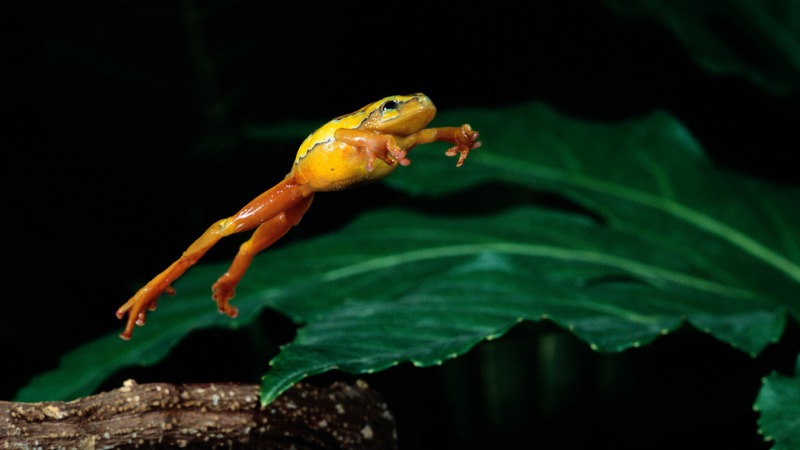
- Swimming
Many amphibians, including frogs and salamanders, possess webbed feet and a streamlined body; some also use lateral undulation of their body and tail. These adaptations reduce water resistance and enhance propulsion in aquatic environments. For example, the Bullfrog (Lithobates catesbeianus) uses its webbed hind feet and powerful leg muscles to swim efficiently in ponds and lakes.
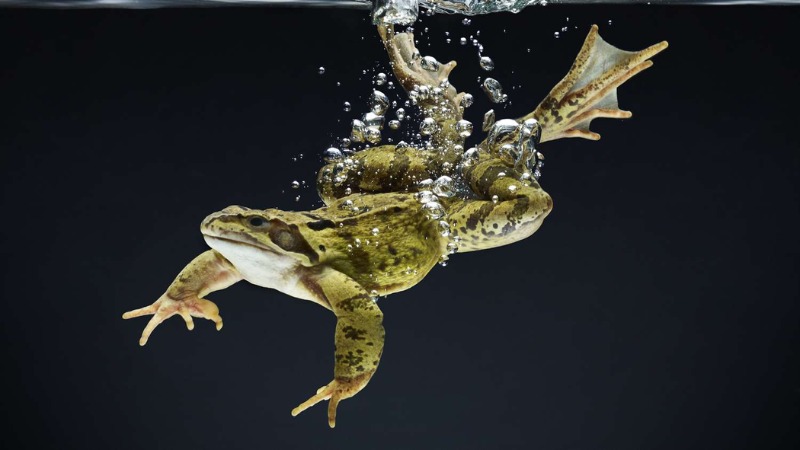
- Burrowing
Burrowing species have short, strong limbs; some have specialized spades on their hind legs. This enables them to dig into soil or substrate to escape predators, avoid extreme temperatures, or maintain moisture. For example, the Spadefoot Toad (Scaphiopus holbrookii) uses its hind legs, equipped with keratinized spades, to burrow into the ground.
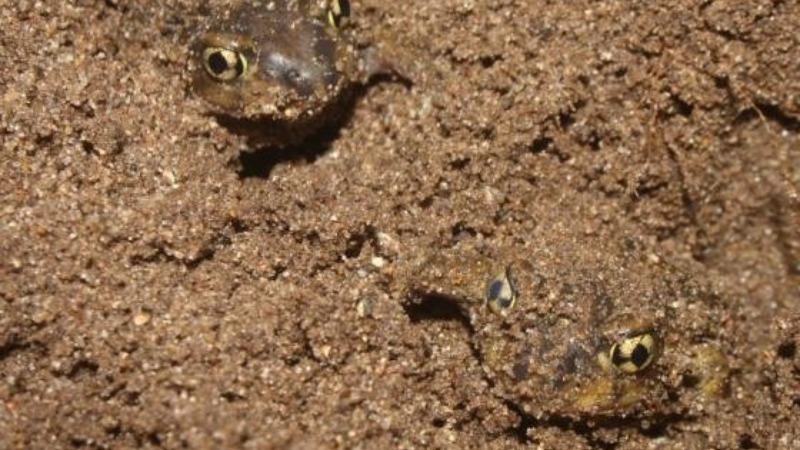
- Gliding
Some tree-dwelling frogs have webbed hands and feet, and extended skin flaps between limbs. These features act as parachutes or wings, allowing the frog to glide or leap longer distances through the air, escaping predators or moving between trees. For example, the Wallace’s Flying Frog (Rhacophorus nigropalmatus) can glide through the air, thanks to its webbed feet and skin flaps.
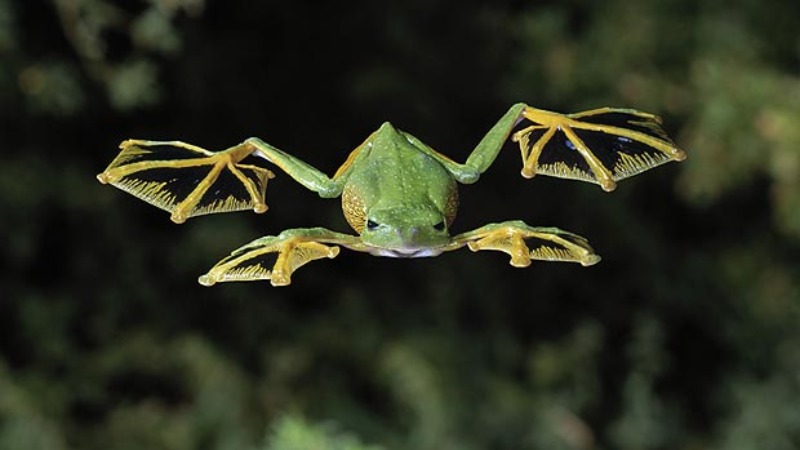
- Serpentine Locomotion
Aquatic salamanders and some amphibians have elongated bodies and tails, facilitating a side-to-side motion. This movement mimics the serpentine motion of snakes, allowing efficient navigation through water. For example, the Amphiuma, with its eel-like body, exhibits serpentine swimming in its aquatic habitat.
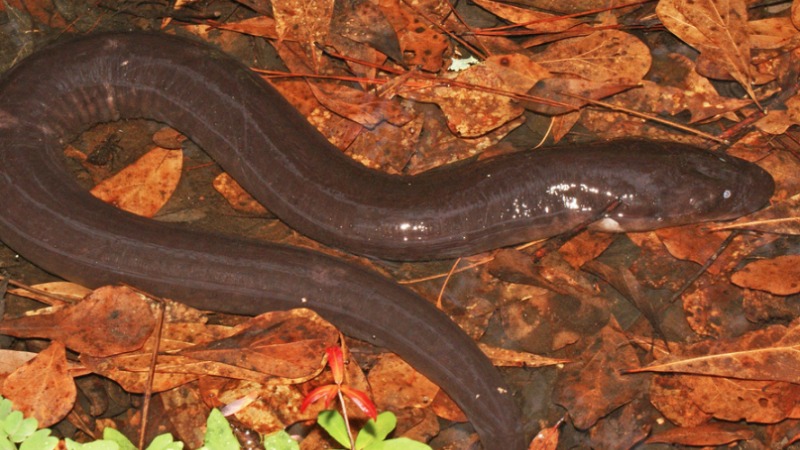
Communication
Amphibians communicate through 4 means, including vocalizations, visual signals (body language), chemical cues, and tactile signals.
- Vocal Communication (Sound)
Frogs and toads (Anura) primarily use vocal communication for mating, territorial defense, and alarms. Males produce sounds by inflating their vocal sacs, amplifying species-specific calls to attract females or warn rivals. The Green Tree Frog (Hyla cinerea) emits loud mating calls, while the American Bullfrog (Lithobates catesbeianus) uses deep, resonating sounds to claim territory. Poison Dart Frogs (Dendrobatidae) rely on high-pitched calls to communicate in dense rainforests.
- Visual Communication (Body Movements & Colors)
Many amphibians use visual signals for territory defense, mating, and warning displays. Bright aposematic colors signal toxicity, while body movements like head bobs or leg waves indicate dominance. The Red-Eyed Tree Frog (Agalychnis callidryas) flashes its red eyes to startle predators. The Golden Poison Dart Frog (Phyllobates terribilis) warns enemies with its vivid yellow skin, while salamanders (Plethodon species) wag their tails to display aggression.
- Chemical Communication (Pheromones & Scent Glands)
Salamanders and caecilians rely on chemical signals for mate attraction, territory marking, and predator deterrence. Specialized pheromone glands help males attract females, while toxic secretions deter predators. The Eastern Red-Backed Salamander (Plethodon cinereus) rubs pheromones on females before mating. Caecilians (Gymnophiona) recognize their young and territories through scent. The Fire Salamander (Salamandra salamandra) secretes toxins when threatened.
- Tactile Communication (Touch & Physical Contact)
In species where visual and vocal signals are less effective, tactile communication plays a crucial role in mating and social bonding. Some amphibians nudge or touch their partners before reproduction, while others use body contact to recognize kin. The Axolotl (Ambystoma mexicanum) uses tail movements to guide females to sperm deposits. Caecilians (Typhlonectes natans) engage in body rubbing to identify family members.
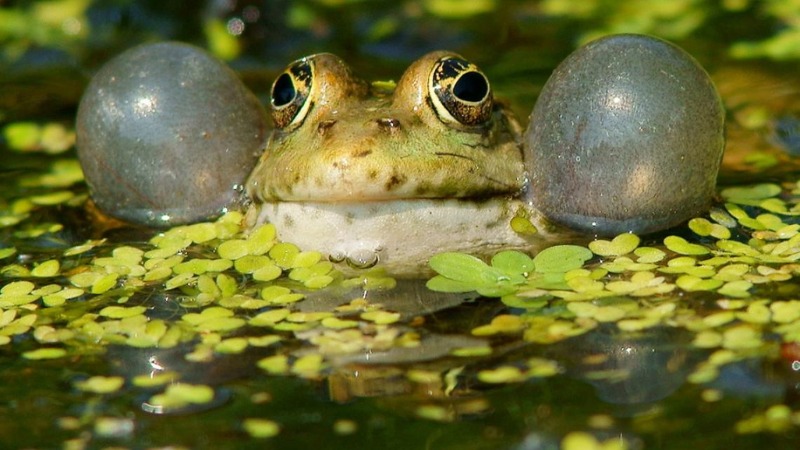
Reproduction
Most amphibians are oviparous, meaning they lay eggs. These eggs are often laid in water or moist environments to prevent desiccation. The reproduction process begins with mating rituals, including vocalizations, visual displays, and pheromone release. After fertilization, egg development varies by species. In many cases, amphibian larvae, such as tadpoles, undergo metamorphosis, transitioning from an aquatic larval stage to a terrestrial adult form.
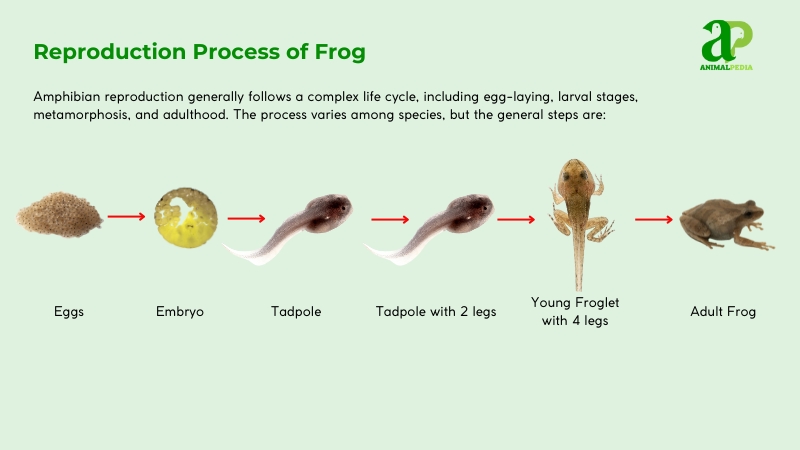
Amphibians display diverse parental care strategies, from abandoning eggs to actively feeding offspring. Most species exhibit no parental care, laying hundreds or thousands of eggs to compensate for high mortality, as seen in the American Bullfrog (Lithobates catesbeianus). Some, like Hellbender Salamanders (Cryptobranchus alleganiensis), guard eggs to protect them from predators.
Others transport eggs or tadpoles, such as the Midwife Toad (Alytes obstetricans), which carries eggs on its legs. A few species give birth to live young, like the Alpine Salamander (Salamandra atra), while Poison Dart Frogs (Dendrobates spp.) feed tadpoles with unfertilized eggs.
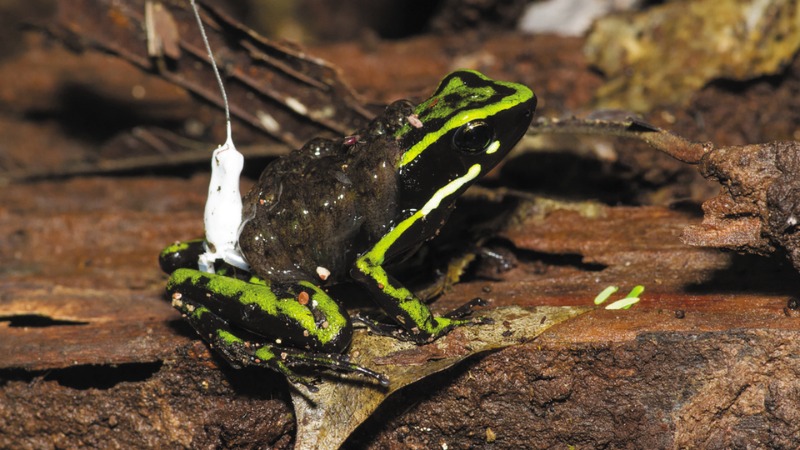
Schooling
Amphibians generally do not form large, coordinated schools like fish, but some species exhibit grouping behaviors at different life stages for protection, feeding, and environmental regulation.
- Tadpole Schooling
Tadpoles often form dense, moving groups to reduce predation, making it harder for predators to target individuals. Grouping also improves foraging efficiency, as tadpoles collectively graze on algae. In colder waters, clustering helps regulate body temperature by retaining heat.
- Juvenile Aggregations
After metamorphosis, some young frogs and salamanders temporarily stay in small groups to maintain moisture and detect predators. This behavior provides short-term survival benefits before they disperse into their adult habitats.
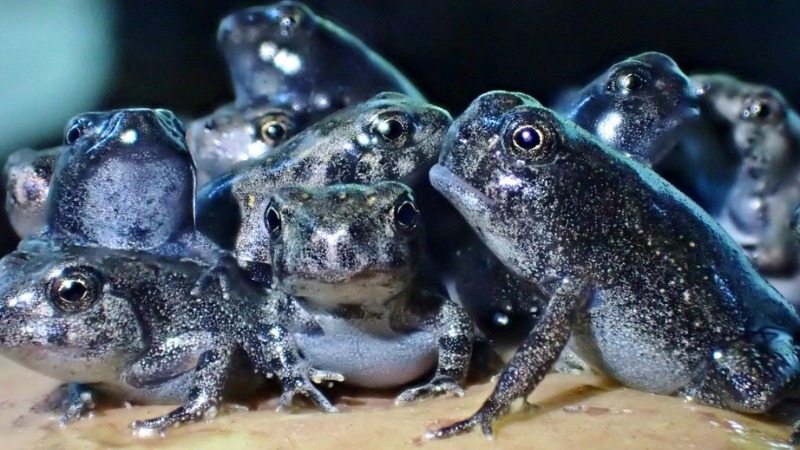
Migration
The most common reason for amphibian migration is to reach optimal breeding grounds, often aquatic environments, where they can lay eggs and their larvae can develop. Amphibians may migrate to avoid unfavorable conditions such as drought or extreme temperatures. They seek out habitats that provide sufficient moisture and suitable temperatures for survival.
Amphibians often undertake seasonal migrations to adapt to environmental changes and fulfill their life cycle needs, such as breeding or hibernation. These migrations are driven by seasonal cues and are crucial for their survival and reproduction
- Spring: Many amphibians migrate in early spring to breeding sites. For example, the common toad (Bufo bufo) undertakes nocturnal migrations to reach water bodies where they breed.
- Autumn: Some species, like the spotted salamander (Ambystoma maculatum), migrate to underground hibernacula to overwinter, moving away from breeding ponds after the summer breeding season.
The migration process often involves amphibians moving en masse from one habitat to another. Amphibians usually follow the same routes year after year, using environmental cues such as temperature and humidity changes, or even celestial navigation. For example, each spring, spotted salamanders across the northeastern United States embark on a synchronized migration to vernal pools for breeding. This event occurs on the first warm, rainy night of spring, often called “Big Night.”
Poison Skin
Amphibians possess a unique anatomical feature that enables them to secrete toxins through their skin: specialized glands known as granular glands. These glands are embedded in the layers of the skin and are responsible for producing and releasing a wide array of substances, including toxins that can deter predators, prevent microbial infections, and sometimes aid in the amphibian’s immunity.
A prime example of an amphibian utilizing its poison skin for defense is the poison dart frog (genus Dendrobates). These brightly colored frogs are found in Central and South America and are renowned for the potent toxins they produce. The granular glands in their skin secrete alkaloid toxins, which can be lethal to predators. The toxins can cause paralysis and even death, depending on the species and the amount of toxin exposure.
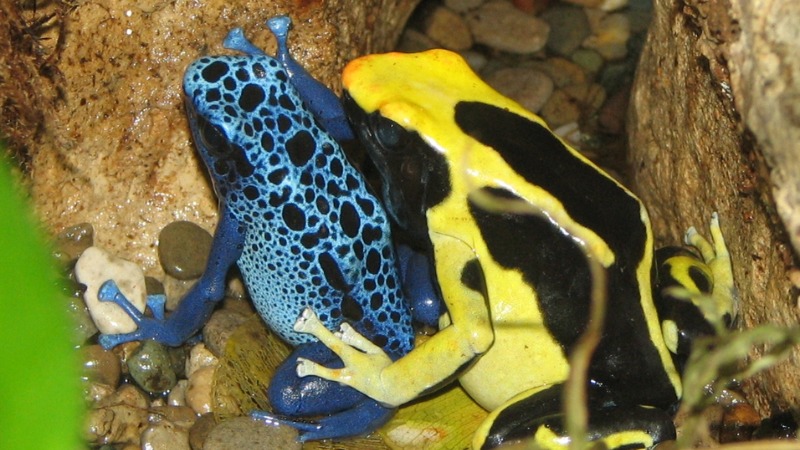
Camouflage and Mimicry
Camouflage enables amphibians to remain undetected by predators. By blending into their surroundings, they can avoid being seen and thus reduce predation risk. Some amphibians, such as Moor Frogs, Chameleon Grasshoppers, or Gray Treefrogs, use their coloration to regulate body temperature. Lighter colors reflect sunlight, while darker colors absorb heat, helping these cold-blooded animals maintain their body temperature.
Some species include Poison dart frogs, Panamanian Golden frogs, Bower’s Mantella, etc. Camouflage and mimicry are also used in mating rituals. Bright colors or unique patterns can signal fitness, attracting mates while also serving as a form of mimicry to warn potential predators of toxicity.
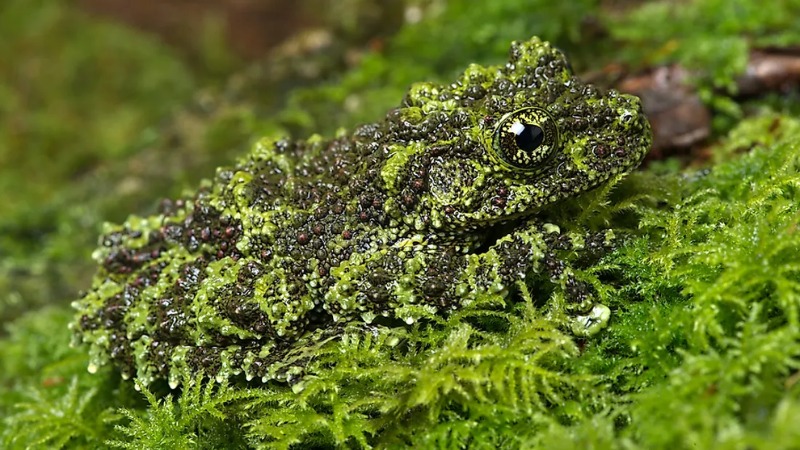
What is the relationship between Amphibians and Humans?
Amphibians and humans have a complex and interconnected relationship, influencing each other in various ways, including cultural, economic significance
- Medical & Scientific Research
Amphibians play a vital role in medical advancements due to their unique biological traits. Their skin secretions contain over 400 antimicrobial peptides, which are being studied for new antibiotics and antiviral drugs, including treatments for HIV and antibiotic-resistant bacteria. Axolotls can regenerate limbs, spinal cords, and even parts of their heart and brain, making them valuable for tissue regeneration research. Frog embryos are widely used in developmental biology and toxicology, contributing to over 50 Nobel Prizes in medicine. Poison Dart Frogs produce epibatidine, a compound 200 times more potent than morphine but non-addictive, inspiring new painkillers.
- Ecological Importance (Pest Control & Biodiversity)
Amphibians help control insect populations, reducing disease spread and crop damage. A single bullfrog can eat over 5,000 mosquitoes in one summer, limiting the spread of malaria and dengue. Frogs consume over 50% of agricultural pests, reducing reliance on pesticides. Salamanders contribute to forest ecosystems by consuming billions of invertebrates, maintaining balance in food chains.
- Cultural Significance of Amphibians
Amphibians have long symbolized transformation, fertility, and wisdom in various cultures. Frogs and toads frequently appear in mythology, literature, and folklore as magical or spiritual beings. In Ancient Egypt, the goddess Heket, depicted with a frog’s head, represented fertility and rebirth. In China and Japan, frogs are believed to bring good luck and prosperity, while European folklore, such as The Frog Prince, highlights themes of transformation and enchantment.

- Economic Significance of Amphibians
Amphibians play a role in the food industry, pet trade, and traditional medicine. The frog legs trade is a major industry, with over 3,000 tons consumed annually, particularly in Indonesia, a leading exporter. The exotic pet market also thrives, featuring species like poison dart frogs, axolotls, and tree frogs, though illegal wildlife trade poses conservation challenges.
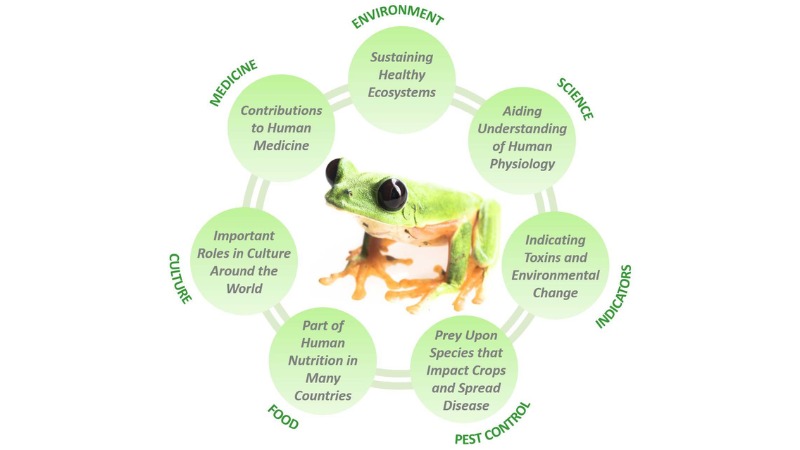
Are Amphibians endangered?
Yes, according to the International Union for Conservation of Nature (IUCN), amphibians are one of the most threatened vertebrate groups, with approximately 41% of species at risk of extinction. Over 2,000 species are classified as endangered or critically endangered. Notable examples include the extinct Golden Toad (Incilius periglenes) and the critically endangered Chinese Giant Salamander (Andrias davidianus).
The decline of amphibians is driven by four factors:
- Habitat Destruction: Deforestation, wetland drainage, and urbanization have drastically reduced habitats.
- Environmental Changes: Climate change and UV-B radiation disrupt breeding and survival.
- Disease: The chytridiomycosis fungal infection has caused catastrophic population losses.
- Human Exploitation: Over-collection for the pet trade and traditional medicine adds further pressure.
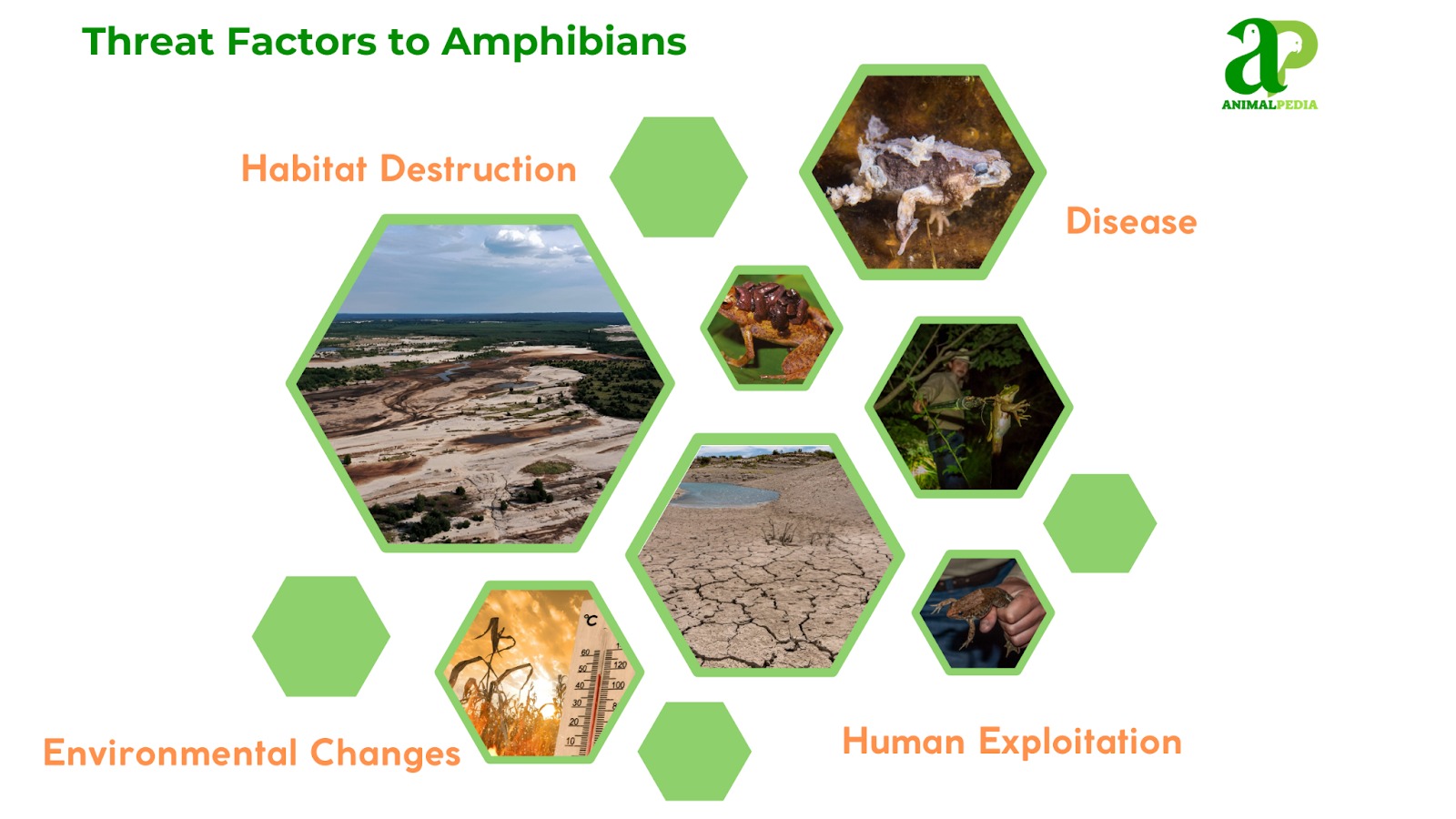
These declines have far-reaching ecological consequences. Amphibian loss disrupts food chains, leading to potential increases in pest insects and affecting ecosystem balance. Their roles in maintaining water quality and nutrient cycling are also compromised. Additionally, the extinction of amphibian species erases potential medical discoveries, as their skin secretions often hold valuable pharmaceutical properties. Urgent conservation efforts are essential to protect these vital species and their ecosystems.
How to save endangered species of Amphibians?
Global conservation efforts for amphibians have intensified, with around 500 species currently benefiting from active programs. Initiatives like the Amphibian Ark, launched in 2006, coordinate protection efforts across 60 countries, focusing on habitat restoration and species recovery.
Six key conservation strategies include:
- Protected Areas: Establishing reserves to safeguard critical habitats.
- Captive Breeding: Raising amphibians in specialized facilities to boost populations.
- Disease Management: Developing treatment protocols and preventive measures for devastating infections like chytridiomycosis.
- Gene Banks: Preserving genetic diversity for future reintroduction.
- Community Engagement: Involving local stakeholders in conservation activities.
- International Collaboration: Supporting coordinated recovery and protection efforts.
These approaches have led to notable successes, such as the recovery of the Wyoming Toad and Puerto Rican Crested Toad, both of which have been saved from near extinction through targeted conservation programs. Continued global cooperation and innovative strategies are essential to secure the future of amphibians.
FAQs
How do amphibians breathe underwater?
Amphibians have various methods for breathing, including through their skin, which is known as cutaneous respiration. When underwater, many amphibians can absorb oxygen directly through their moist skin.. Additionally, larval stages of amphibians, such as tadpoles, possess gills that enable them to extract oxygen from water, much like fish.
Can amphibians fly?
No, amphibians cannot fly. While some amphibians, like certain species of frogs, can glide or leap long distances through the air to escape predators or move between trees, this is not considered true flight.
Are fish amphibians?
No, fish are not amphibians. Fish and amphibians are distinct classes of vertebrates. Fish belong to the class Pisces and are adapted to living their entire lives in water. They breathe using gills and have scales covering their bodies.
What is the largest amphibian in the world?
The largest amphibian in the world is the Chinese giant salamander (Andrias davidianus), which can reach lengths of up to 1.8 meters (nearly 6 feet).
Are all amphibians cold-blooded?
Yes, all amphibians are cold-blooded, or ectothermic, meaning their body temperature is regulated by external sources of heat.
Amphibians, a vital link between aquatic and terrestrial life, showcase nature’s adaptability through their dual life cycle, unique physiology, and diverse behaviors. Their evolution from lobe-finned fish marks a critical shift in vertebrate history, enabling ecological roles like pest control and medical advancements. However, with 41% of species endangered due to habitat loss, disease, and climate change, amphibians urgently need our protection.
By understanding their fascinating traits—like axolotls retaining larval features—and supporting conservation efforts, we can help preserve their crucial contributions to ecosystems and humanity. Let’s champion amphibian survival for a thriving biodiversity.

